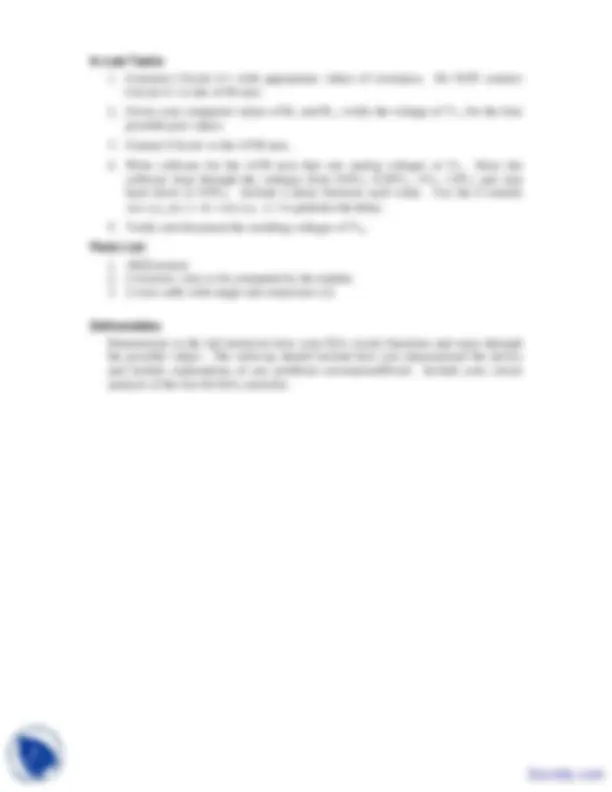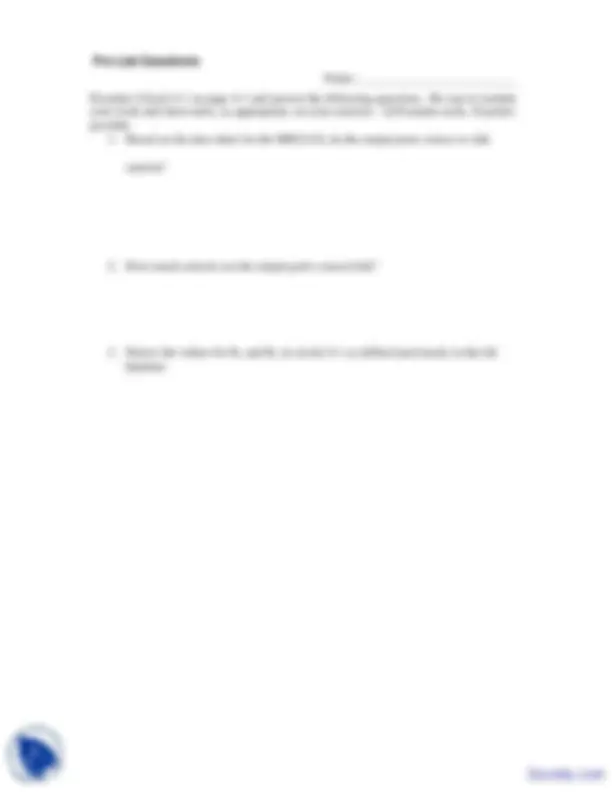




Study with the several resources on Docsity

Earn points by helping other students or get them with a premium plan


Prepare for your exams
Study with the several resources on Docsity

Earn points to download
Earn points by helping other students or get them with a premium plan
Community
Ask the community for help and clear up your study doubts
Discover the best universities in your country according to Docsity users
Free resources
Download our free guides on studying techniques, anxiety management strategies, and thesis advice from Docsity tutors
A lab exercise for designing a two-bit digital-to-analog converter (dac). Students are required to analyze equivalent circuits, derive resistor values, and write software for the avr microcontroller to generate analog voltages. The document also includes pre-lab assignments and deliverables.
Typology: Study notes
1 / 4

This page cannot be seen from the preview
Don't miss anything!



Circuit 4-1 – A Two Bit DAC (ECE 5430 students, a four-bit DAC with an op-amp is required)
The requirement for this D/A converter is that it needs to generate at VA voltages of 0.0VS, 0.30VS, 1.0VS and a value approximately halfway between 0.30VS and 1.0VS. The value of VS is the reference voltage of the board. This midway voltage is left as a variable so that the resulting calculations have an extra degree of freedom.
Background
Typically, a D/A chip is used to convert a digital value into an analog signal. Many D/A chips use similar 2R-R ladders, although other methods are possible. Understanding the internal structure of a D/A converter does assist the designer even when using standard packages/chips.
The Pre-Lab Questions require circuit analysis to derive the values for resistors R 2 and R 3 in Circuit 4-1. For this lab, use a value of 1000 Ohms for R1. This lab description sets up two analyses of equivalent circuits for the digital values 2’b11 and 2’b00. You will have to analyze the circuits for the remaining two values and solve a system of equations to determine the unknown resistor values.
You can solve the system of equations manually. However, for this lab you might want to use a Computer Algebra System (CAS). Here at UCCS we use mostly MATLAB or Maple. At this point, you should become familiar with both software packages.
R1 = 1000 ohm
Circuit 4-2 – An Equivalent Circuit to Circuit 3-3 when port 0 =port 1 =’1’
When ports 0 and 1 are both logical “1” they set a 5V value on their respective pins. Since they have the same supply voltage and have one connection in common they appear as if they are in parallel.
2 3 1
1 R R R
VA is required to be ≥ 4 Volts when the D/A is set to 2’b11, therefore:
2 3 1
1 ( || )
The port values of 2’b00 correspond to circuit that has no potential drops. Therefore, the resistors can have any value. Use Equation 3-2, along with others that you will derive to solve for R 2 and R 3.
You need to derive equivalent circuit equations for the remaining two values of ports 0 and 1. That is, when port 1 =1 and port 0 =0 (2’b10) and for 2’b01. At this point you could use Maple to solve the 3 equations for 3 unknowns. For 2’b10 let the voltage for VA be a parameter, say V 2 and let Maple tell you what values V 2 can be given the constraint 0.30<V 2 <1.0. Be sure to include a copy of the output from the CAS with your lab write- up if you use Maple or Matlab.
Note: Maple is installed on the workstations on the first floor of the Engineering & Applied Science building.
Pre-Lab Assignments for Circuit 3
Pre-Lab Questions Name: __________________________
Examine Circuit 4-1 on page 4-1 and answer the following questions. Be sure to include your work and show units, as appropriate, on your answers. 2/2/6 points each, 10 points possible.
current?